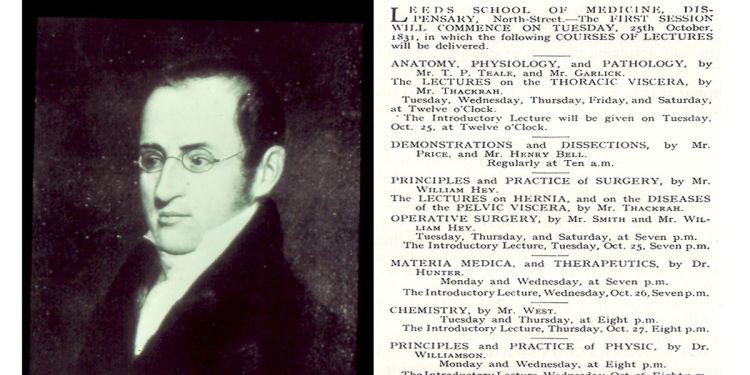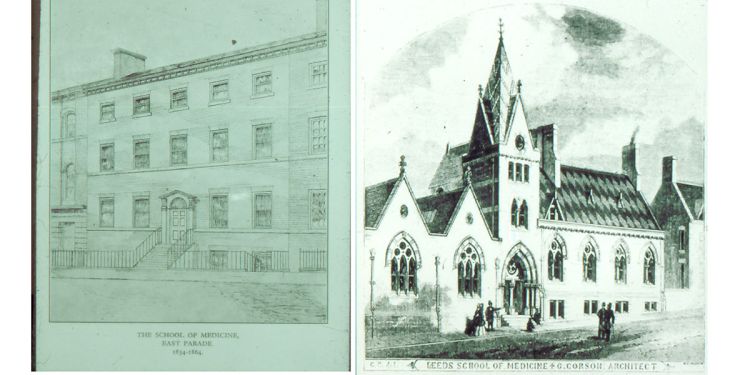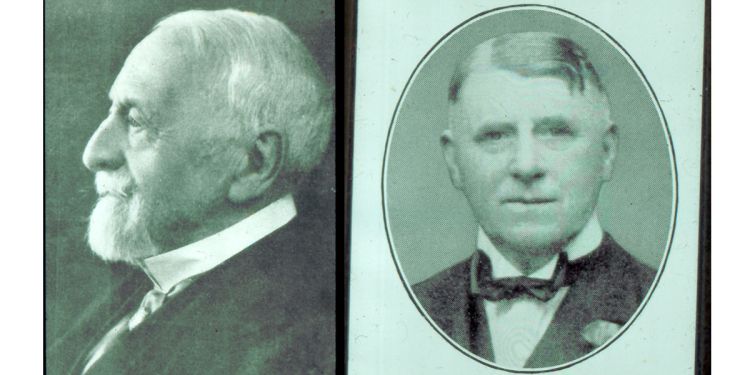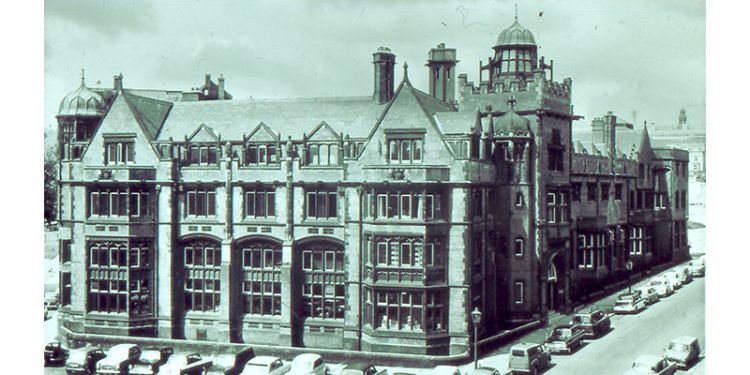History of the School of Medicine
The Leeds School of Medicine
The School of Medicine was founded in 1831, but its origins lie in the establishment of a School of Anatomy by Charles Turner Thackrah in 1826 at 9 South Parade, Leeds. The School was set up in order to prepare young men for a surgical apprenticeship at the General Infirmary at Leeds, founded in 1767.
Thackrah, born in 1795, had been apprenticed at Leeds and had studied at Guy’s, earning his diploma of membership of the Royal College of Surgeons in 1816. He returned to Leeds and was appointed to the post of Town Surgeon, with responsibility for the poor-law patients, He became joint secretary to the Leeds Philosophical and Literary Society on its foundation in 1819. He supervised apprentices and delivered popular public lectures on physiology, though attracting criticism from the medical press and the surgeons at the General Infirmary.
In the ten years prior to 1831 five new medical schools were founded in England and there was growing pressure for there to be one in Leeds with its rapidly growing population and being one of the major industrial towns in England. In June 1831 a group of surgeons and physicians of the Infirmary and the Public Dispensary resolved to establish one.
Having settled his differences with the surgeons, Thackrah was invited to join them and five months later the first session opened in rooms in the Public Dispensary in North Street. Thackrah died two years later of tuberculosis and is remembered not only as the founder of medical education in Leeds but more often as the ‘Father of Occupational Medicine’ on account of his seminal work on occupational ill-health and diseases, arising from the factories and workshops widespread in the north of England.

(left) Charles Thackrah, pioneer in the field of occupational medicine and was a founder member of the Leeds School of Medicine, (right) Part of the timetable of lectures from the first term of the opening session of the Leeds School of Medicine in October 1831.
The School from 1831 to 1894, East Parade and Park Street
The premises of the Dispensary proved too small and in 1834 the School acquired 1 East Parade, very close to the site of the Infirmary, at that time on what is now Infirmary Street, Leeds. It moved again in 1865 to purpose-built premises in Park Street to accommodate an annual intake of about 40 students. These premises were close to the site on which the new and present Infirmary was being built.
In 1864 Dr Clifford Allbutt joined the Infirmary and became a member of the School. Allbutt was an innovator, credited with introducing the weighing machine, the taking of blood pressure and the microscope to the Infirmary. He is most widely known for the development of the short-stemmed clinical thermometer.
Clinical instruction was largely given at the Infirmary, but between 1868 and 1875, Dr Crichton Brown lectured in mental diseases and held a weekly clinic at the West Riding Lunatic Asylum in Wakefield. Crichton Brown was the leading doctor in his field and the first six volumes of the Reports of the Asylum are the direct predecessor of the journal Brain which he founded and edited.
On the broader educational scene, Dr John Deakin Heaton, a former student of the School and Physician to the Dispensary, and President of the Council of the School between 1850 and 1873, was appointed as vice-chair of the funding committee for a college of science in Leeds. This opened in 1874 as The Yorkshire College of Science, the forerunner of the University of Leeds.
The science teaching in the Medical School immediately transferred to the Yorkshire College and in 1884 the School itself became the Medical Department of the College. Thomas Scattergood, a former student of the school, became the School’s first Dean and remained so until he retired in 1900.
In 1887 the Yorkshire College became part of the Victoria University of Manchester University and in 1894 a new building, now known as the Old Medical School, on Thoresby Place was built for the School, with the capacity for the admission of 80 students annually.

The School of Medicine's premises on East Parade (left) and Park Street (right)
Surgery in Leeds
Surgery was a major strength of the School following the establishment of the Yorkshire College. Thomas Jessop, another former student, became the first Professor of Surgery and is credited with the first successful removal in the UK of a kidney tumour. His successor Ferguson McGill in 1887 performed the first suprapubic prostatectomy. He was succeeded by Sir Arthur Mayo-Robson who built a reputation as a surgeon of the gall bladder and bile duct.
Former Leeds student Berkeley Moynihan, who had been dresser to McGill and then house-surgeon to Mayo-Robson, became Lecturer in Surgery in 1890. Following a visit to the USA in 1897 he introduced sterile clothing to the infirmary and after a second visit in 1903, rubber gloves. The leading surgeon of his day, he made major advances in techniques in abdominal surgery, became Professor of Surgery in 1910 and was President of the Royal College of Surgeons from 1926 to 1931, the first surgeon from outside London to do so, and was elevated to the peerage.

(Left) Sir Clifford Allbutt, inventor of the clinical thermometer, (right) Lord Moynihan introduced sterile clothing to the infirmary
The University of Leeds
With the granting of the charter to the University of Leeds in 1904, the association with Manchester ceased and the Medical Department of the Yorkshire College became the Faculty of Medicine of Leeds University. Amongst the first members of staff appointed was Friederich Eurich, a bacteriologist who became Professor of Forensic Medicine in 1908, who is known for his discovery of the cause of sub-cutaneous anthrax (wool-sorters’ disease), in the imported fleeces to the Bradford woollen industry.
For thirty years after World War 1, the School was dominated by Professor JK Jamieson, Dean 1918 - 1935 and Professor Matthew Stewart, Dean 1941-1948. Both played major parts in University affairs. Jamieson’s deanship saw the building of the Physiology extension to the School in Thoresby Place in 1930 and the Algernon Firth Building to house Pathology, Bacteriology and Cancer Research in 1933.
Matthew Stewart was one of the first to realise that asbestos was a cause of cancer and he initiated the establishment of the chair of experimental pathology and cancer research in 1926. He was the leading pathologist of his day and edited the Journal of Pathology and Bacteriology from 1934.
After the Second World War amongst the Leeds alumni who achieved distinction is William Pickles, who became a GP in the Yorkshire Dales, became well-known for his Epidemiological studies, and became the first President of the College of General Practitioners in 1953. Two others, Leslie Pyrah (MBChB 1924) and Frank Parsons (MBChB 1943), established at the Infirmary the first Artificial Kidney Unit outside London.
With the appointment of Sir Ronald Tunbridge in 1946 to the Chair of Medicine, the first full-time University clinical chair, the University now had a voice on the Infirmary’s appointing committees. As a result, the status of teaching was enhanced and the seeds were sown for the growth of academic medicine. In the late 1960s the existing facilities in Thoresby Place were proving insufficient for the rising intake of students (130 in the early 1970s), and pre-clinical teaching was accommodated in new buildings on the University campus while new clinical departments were established at St James’s Hospital, some of them housed in the Wm Tweddle Clinical Sciences Building.
In 1968 plans were drawn up under Professor Derek Wood, for new medical school facilities for an intake of 216 and in 1979 the Worsley Building on the University campus was opened. It was to be another 20 years though before this target was reached.

Leeds School of Medicine - The Old Medical School, Thoresby Place 1967
The School today
Since the late 1980s there has been continuous evolution in the structure and academic development of the School, and further growth in the number of students. New Institutes have been built, the Old Medical School is now managed by the Leeds Teaching Hospital Trust and the Algernon Firth Building has been sold for flats. The History of the School up to the 1980s is presented in a mural located in the Library in Worsley Building and you may pay a virtual visit to it by going to the Mural on the next page.
Further information
For the School’s present structure and activities visit our website here.
Bill Mathie
Secretary to the School of Medicine 1981-2007.
October, 2019

